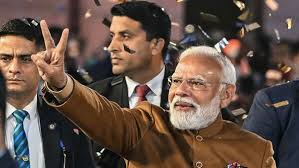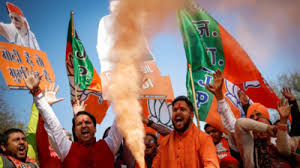After victory in Delhi, BJP intensifying deliberations on CM selection
 NEW DELHI : After being out of power for 27 years, BJP made a spectacular comeback in the Delhi Assembly elections by defeating Arvind Kejriwal’s Aam Aadmi Party (AAP) badly, and after that deliberations have intensified within the BJP on the selection of the future Chief Minister of the national capital.
NEW DELHI : After being out of power for 27 years, BJP made a spectacular comeback in the Delhi Assembly elections by defeating Arvind Kejriwal’s Aam Aadmi Party (AAP) badly, and after that deliberations have intensified within the BJP on the selection of the future Chief Minister of the national capital.
By winning 48 seats on its own in the 70-member Legislative Assembly, BJP has put an end to the rule of Arvind Kejriwal’s AAP. AAP got only 22 seats.
Arvind Kejriwal, who rose to the political horizon of Delhi by talking about India Against Corruption in the Anna movement against political corruption, fell due to corruption. Liquor scam, false promises, colorful illusions and the Chief Minister’s residence “Sheesh Mahal” decorated at the cost of Rs 33 crore, threw him out of power in Delhi after 12 years with a bang. He had to face the anti-government wave. The people of Delhi were so angry with the AAP government’s actions that they defeated its top leaders, including AAP party chief and former chief minister Arvind Kejriwal and his former deputy Manish Sisodia. Riding on the anti-incumbency wave, incumbent chief minister Atishi won the election from Kalkaji constituency.The Congress has maintained its record of defeat in the last two elections in the capital.
The single-phase election on February 5 saw a voter turnout of 60.54%. The AAP secured around 44% of the votes and was respectably behind the BJP, which got around 46% of the votes. The Congress, on the other hand, could not win a single seat, but its vote share increased from 4.26% in 2020 to around 6.40% this time. The win in Delhi will put the BJP or its alliance in power in 19 states in 2025.
Among the few names being discussed as the future chief minister of Delhi, the first is Pranab Verma. Verma registered a comfortable win over a beleaguered Kejriwal by over 4,000 votes. Verma is a two-time Lok Sabha MP and the son of former Delhi chief minister Saab Singh Verma. Three of the last four chief ministers have won the New Delhi seat. Kejriwal won it in 2013, 2015 and 2020 and his predecessor Sheila Dixit of the Congress won it in the 2008 election. But Verma’s name is not on the shortlist. However, according to a top BJP leader, there are five candidates for the post, including Mr Verma. The party will balance various factors, including caste.
Parvesh Verma
Making Mr Verma the chief minister will send a strong message to the Jat community, from which the new MLAs of New Delhi come. Jat votes helped ensure the BJP’s victory in the Haryana election last year, as well as wrest Rajasthan from the Congress and strengthen its hold on Uttar Pradesh. Parvesh Verma met Union Home Minister Amit Shah soon after his victory was confirmed, who is credited with BJP’s remarkable Delhi win – another sign in his favour.
Satish Upadhyay – The other option is Satish Upadhyay, who prevented AAP leader Somnath Bharti from winning for the fourth time in a row from Malviya Nagar Assembly constituency. Mr Upadhyay is considered the Brahmin face of Delhi BJP. He was the head of the party’s state unit and importantly for him, he also served as the vice-chairman of the New Delhi Municipal Corporation, which means he has administrative experience directly related to the national capital, which Mr Verma probably does not have. Another point in Mr Upadhyay’s favour is that he has held several other senior positions within the BJP and is also close to the Rashtriya Swayamsevak Sangh, the ideological mentor of the BJP.
Ashish Sood – BJP’s Punjabi face Mr Sood is the new MLA from Janakpuri Assembly constituency, which was a BJP (impregnable) bastion till 2015, when AAP’s Rajesh Rishi won twice. Mr Sood’s previous administrative experience includes serving as a Delhi councillor and general secretary of the party’s Delhi unit. He is also in-charge of the party’s unit in Goa (where the next election will be held in 2027) and co-in-charge of Jammu and Kashmir. Other points in Sood’s favour are his close ties with the BJP’s central leadership and his tenure as Delhi University president.
Vijender Gupta– The fourth and fifth names on the list are Vijender Gupta. He comes from the Vaishya community. Of which Vijender Gupta is probably the more preferred of the two choices. Mr Gupta was the president of the Delhi BJP and is seen as the Vaishya face of the party. He has now become an MLA three times from the Rohini assembly seat and has also been the leader of the opposition twice.
Buoyed by the ‘Modi wave’ and votes from women, the middle class and the Poorvanchal community, the BJP ended Arvind Kejriwal’s decade-long hold on Delhi. The AAP, which had registered landslide victories in the 2015 and 2020 elections, winning 67 and 62 of the 70 seats in Delhi each time, faced a crushing defeat this time.
ड़ा।

